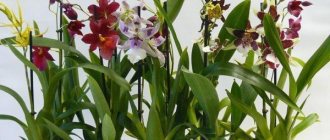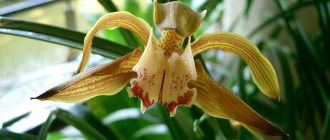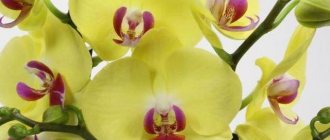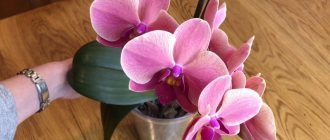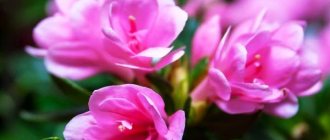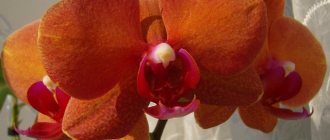A masterpiece of hybridization, the Beallara orchid
Beallara is truly a masterpiece of hybridization.
There are up to 15 large flowers on long (up to 50 cm) peduncles emerging from the leaf axils. Large flowers, up to 20 centimeters in diameter, have many color variations. A distinctive feature of the beallar is the unique pattern of spots on the sepals and lip. The shape of bealara flowers resembles stars. The flowering of beallara is a unique and fascinating spectacle. The undeniable advantage of this orchid is that at the same time one bulb can produce 2 peduncles at once. To create beallara, breeders took the best traits of brassia, miltonia and oncidium. The resulting orchid turned out to be not only beautiful, but also easy to care for.
At home, caring for beallara will not cause any difficulties even for novice orchid collectors.
Temperature
Since beallara is not a natural species, it is difficult to name the optimal temperatures for its comfortable existence. There is nothing to focus on. A huge number of different hybrids has led to the fact that the range of temperatures favorable for beallara has expanded. There are cold-loving and heat-loving hybrids. It is almost impossible to find out which one your beallara belongs to when purchasing, so you will have to observe your plant and calculate them experimentally.
Estimated temperatures are 18-35 degrees during the day and 16-20 at night. For the comfortable existence of this orchid, you will have to take care to reduce temperatures by at least 4 degrees at night. The lack of temperature difference affects the flowering frequency of beallara.
Necessary lighting parameters for Beallara
The beallar orchid is light-loving and tolerates direct sunlight well. But this does not mean that immediately after purchasing you can put the pot in the sun. In stores, orchids are not given good lighting, so gradually accustom the orchid to the bright sun.
In winter, it is advisable to extend the beallara daylight hours using a fluorescent lamp.
Air humidity and watering Beallary
The key to successfully growing any orchid is a high level of humidity, and beallara is no exception. Therefore, equip the location of the beallar with containers with wet expanded clay.
Water beallara as the substrate dries. It’s not scary if the orchid sits in completely dry bark for a couple of days. Stagnation of water in a pot is destructive. Make sure that after watering the remaining water flows out of the pot easily. To do this, you will have to make many holes across the entire surface of the pot. The best watering method is a hot shower. The water temperature must exceed the temperature of the human body. During flowering, it is not recommended to wet the flowers. This may cause brown spots to appear on their surface.
Which sibling should Beallara be transplanted into?
There is no need for frequent transplants. There are only two reasons for them. Beallara is replanted in case of decomposition of the substrate (the bark has turned into dust) and as it grows.
The composition of the substrate can be as follows: chopped fern roots, small pieces of peat, sphagnum and bark. There is no need to compact the substrate. The roots must have access to air.
Life stages
The beallar orchid does not have a dormant period, but can go into hibernation in the winter. For this, a long absence of bright lighting will be sufficient. There is also no clearly defined period for increasing green mass. Beallara is capable of simultaneously producing new shoots and peduncles. Problems of identifying roots and peduncles are not relevant for this orchid. New shoots appear in the form of small bushes, over time a bulb forms at the base of them. The peduncle grows exclusively from the leaf axil.
Diseases and pests of Cumbria, their treatment
Cambria, if cared for correctly, gets sick quite rarely. Most often, diseases develop in a plant if it is watered incorrectly: too much, without proper technique, in insufficient quantities. Here are some of the most “popular” diseases of this type of orchid.
Rust
This disease is fungal. It is caused by rust fungi. Drafts contribute to their development. The disease can be identified by the red convex bubbles on the inside of the leaf blades. Sometimes they crack and release spores. For treatment, drugs such as Mikosan, Spor and Topsin are used.
Anthracnose
It is also fungal in nature. Sometimes it is mistaken for burns, but the burn looks just like a dot on the leaf, and the anthracnose stain is actively growing. The disease develops best at high humidity and temperature. To combat it, sometimes it is enough to remove all areas of the plant with spots. Next, you need to treat the orchid with a fungicide of organic (or inorganic) origin. Among inorganic drugs, bitertanol and azoxystrobin have proven themselves to be the best.
Powdery mildew
It makes itself known in the form of whitish spots. Over time they turn brown and the leaf dies. Develops under high humidity, poor air circulation, and excessive watering.
We remove the affected areas and treat the diseased plant with fungicides. We repeat the procedure after 10 days.
But this type of orchid is quite susceptible to pest invasion. The most common:
- Shield. Its presence leads to drying of the leaf plate. For control, you can use biological agents (fitoverm, averin) and insecticides (phosphamide, actellik);
- Thrips. Small insects that leave punctures on the leaves. For the fight they use fitoverm, aktar, tanrek;
- Spider mites. Most often they settle on leaves and stems. For the fight, the already mentioned fitoverm, thiophos and actellik are used;
- Whiteflies. They settle under the leaves; yellow orchids are their favorite. To combat parasites, you can lower the air temperature in the room. Systemic insecticides can also be used.
Prevention of diseases and pests
Preventive measures include maintaining the correct temperature, proper watering and controlling the humidity in the room. To avoid air stagnation, ventilate the room with the flower more often.
To avoid attacks by parasites, you can periodically wipe the window sill with the pot with alcohol wipes.
Cambria orchid
Cambria is the trade name of a fairly numerous genus, the representatives of which are considered to be hybrids created by crossing plants from such genera as Brassia, Miltonia, Odontoglossum and some others. Also in flower shops, this plant is often called Aliceara, Bakerara, Beallara, while in the scientific literature it is called ×Degarmoara.
Plants of this genus have a sympodial growth pattern. Thus, the growth of young shoots occurs on a horizontally located shortened stem (rhizome). As they grow, old shoots die off. Oval developed pseudobulbs have a fusiform or flattened shape. On the surface of the thin roots there is a layer of velamen, which has a porous structure. From the upper part of the pseudobulbs grow 2 or 3 green leaves, which reach 50 centimeters in length and have a belt-like or broadly lanceolate shape. The central vein is clearly visible on the surface of the leaf, while the leaf blade itself is slightly folded inward along it.
This orchid can bloom at any time of the year. Multi-flowered peduncles appear from the axils of the lower leaves, most often they are straight, but sometimes they are branched. Such peduncles can reach 60 centimeters in length and contain up to 50 relatively large flowers (diameter up to 7–10 centimeters). Zygomorphic flowers have 5 sepals, which are connected in the shape of an asterisk, and they also have one clearly visible and fairly large lip (modified petal). The color of the flowers can be different, but most of them are variegated (speckles, stains, spots or patterns). Some of the flowers are quite fragrant.
Cumbria Beallara Peggy Root
Orchid Cumbria Beallara Peggy Root
buy in Moscow in an online store with delivery - belongs to the orchid class. This plant was developed by crossing three species of orchids. It is sympodial, i.e. consists of several pseudobulbs and has several growth points. The bulbs are located close to each other like a ladder. Several leaves grow on the straight trunk of the Cambria orchid. Peduncles are formed from leaves that grow below. There can be up to 15 flowers in one peduncle and they reach a length of up to 50 cm. The flowers are shaped like stars. Their average diameter is about 10 cm. When flowering, they smell good.
Temperature
To make the plant comfortable, it must be grown at room temperature - from +16 to +35 degrees. As mentioned above, the temperature should drop at night. Light
Unlike many other orchids, the Cambria orchid loves light and tolerates even direct sunlight. However, one nuance must be taken into account - if the flower stands in a dark place for a long time, then direct sun can damage the leaves. Therefore, the flower must gradually get used to the sun. What pots to keep Cambria Orchid in? A clay or plastic pot is ideal for this plant. The first allows the root system to breathe, and the second retains moisture well. The pot should be small. Soil If you choose a store-bought substrate, it will be ideal. Air humidity In winter, humidity should be lowered, and in summer, increased. This type of orchid absorbs all moisture through roots, leaves and flowers. During the day, when it is in the sun, the moisture evaporates. If there is a lack of heat, moisture will accumulate, which will lead to damage to the plant. Therefore, it is important to maintain a balance of air humidity. Replanting If everything is fine with the orchid, then there is no need to replant it. There are several reasons why a flower needs to be replanted. The first is that there is not enough space in the pot. Second, there are pests. Third, the soil has deteriorated. Watering The frequency of watering will depend on the air temperature. The hotter it is, the more often you need to water. But all excess water must drain from the pot and should not remain on the tray. To avoid flooding the plant, you need to make sure that its substrate is completely dry. Fertilizer The roots of this orchid are very sensitive to phosphorus, potassium and other fertilizers and can deteriorate under their influence. Therefore, it is important to purchase only professional fertilizers. It is necessary to fertilize not only the roots, but also the outer part of the plant. Pests and diseases Pests can live both in the substrate and on the plant itself. These can be various midges, mites, slugs, wood lice, worms, scale insects, aphids and others. In any flower shop you can find special remedies against them that will not harm the plant. Diseases can affect the root system, leaves or flowers. They occur extremely rarely. Most often, leaves and roots suffer from improper watering and care.
Caring for a Cambria orchid at home
Caring for orchids is not as easy as, for example, dendrobiums or phalaenopsis. However, if you have several skills and know the basic rules of care, you can safely grow this beautiful flower at home.
Illumination
It needs bright lighting, but the plant needs to be shaded from direct sunlight. It will feel best on windows of eastern and western orientation. If the cambria is placed on a south-facing window, then it should be slightly shaded from the scorching midday sun.
Main types
Listed below are those species that are most popular among flower growers and can be easily purchased at a flower shop and grown in your apartment.
Vuylstekeara
This is a complex hybrid obtained by crossing Cochlyodes, Miltonia and Odontoglossum. This graceful orchid can have from 5 to 20 fairly large flowers on a peduncle, which are most often colored red, pink or yellow. It blooms for quite a long time, about 8 weeks. The beginning of flowering occurs at the end of winter and the beginning of spring.
Burrageara
This hybrid is even more complex than the previous one. It was created by crossing plants from genera such as Cochliodas, Oncidium, Miltonia and Odontoglossum. The color of the flowers is a variety of combinations of red and yellow shades. The flowers are quite fragrant and their scent is similar to a rose. Flowering occurs in mid-winter.
Beallara
This hybrid was obtained by crossing Brassia, Odontoglossum, Miltonia, and Cochliodae. Flowering occurs from mid to late summer. The flowers have a cream color or pink-white-purple, as a rule, on their surface there is a very large number of different dots and specks of dark color.
Colmanara
This hybrid appeared as a result of crossing Oncidium, Odontoglossum and Miltonia. The plant blooms for quite a long time, 1–3 months. The main color of the flowers is various shades of yellow and red.
Degarmoara
This hybrid was the result of crossing Odontoglossum, Brassia and Miltonia. It has quite large flowers, so their diameter can reach 10 centimeters. Flowering can begin at any time and depends on the maturation of the pseudobulbs. Flowers can have a wide variety of shapes and colors.
Odontocidium
This hybrid is quite simple and was obtained by crossing Oncidium and Odontoglossum. There are up to 50 medium-sized flowers on long peduncles. The flowers can be colored in a variety of combinations of yellow and red, and there are a variety of dark patterns and dots on their surface.
Odontioda
This hybrid is also not complicated. It was obtained by crossing Odontoglossum and Cochlyodes. The color of the flowers is a variety of combinations of yellow and red flowers.
Cambria varieties with photos and names
The varieties of this orchid are very diverse, because it was created on the basis of several types of orchids. But there are also several particularly popular varieties.
Beallara margarita hill
Odontoglossum was used to create this variety. The peduncles are quite tall, the flowers themselves are of average size - up to 6 centimeters. The color of flowers can be very diverse.
Catatante Pacific Sun Sports
This is a fairly undemanding flower that has outstanding hardiness. The peduncle is tall - up to 80 centimeters, the flowers are small and numerous. Interesting with bright orange petals. During flowering in summer, this variety needs cool temperatures.
Colmanara Tropic Jungle
Interesting with its fleshy white-red growth. A tall plant on which 20 red or bright yellow flowers can bloom simultaneously. Flowering lasts about two months.
Odontoglossum Stirbick
Quite a rare variety, which can only be ordered in the Netherlands. Flowering begins in February and ends in April. Feels best in cool conditions, but tolerates heat well. The flowers are large and bright burgundy. Usually forms a large number of pseudobulbs.
Mix
This is not a variety, but in stores you can often find a flower called “Cambria mix”. This only speaks of the hybrid origin of the flower.
Medicinal plants, folk recipes. Health, beauty, nutrition, plants.
Side Column
Side Column
Popular articles
- Sakura is not just a Japanese cherry – 39
- Nightshade (SOLANUM) - “Jerusalem cherry” or “coral tree” - 34
- Poisonous plants (photos with descriptions) - 33,366 views
- Beautiful orchids – 31
- How plants overwinter - 29
- SCINDAPSUS - "devil's ivy" in English - 28,375 views
- Such a different mess. At what age and what kind of porridge can babies be given - 26
- Dates – healthy sweets – 25
- Why do leaves change color in autumn? — 25
- Three ways to grow bonsai: from seeds, cuttings and propagation by air layering - 24
Beallara is an easy-to-care orchid
Beallara is an intergeneric hybrid (parents of the orchid: Brassia/Cochlioda/Miltonia/Odontoglossum), it is suitable for those who have just decided to grow orchids, since it is a plant from the group of oncidium hybrids that is quite suitable for indoor conditions. Beallara flowers are collected in several pieces on a high peduncle reaching up to 50 cm in height. The orchid is unpretentious, easy to grow and blooms easily. The pseudobulbs are elongated, round, and bear two dense leaves at the top.
Content temperature
Beallara prefers moderately warm temperatures, in the summer within +22-26 degrees. Can withstand short periods of heat well. In winter, cooler conditions are needed; the temperature at this time of year is +15-18 degrees. It is necessary to create a year-round temperature difference of 3-5 degrees, so it is better to keep the plant on the windowsill.
Lighting
Windows are suitable, facing west or east. Beallara loves bright sunlight. It can tolerate direct morning or evening sun, which causes the bulbs to begin to turn red, but in the fall they again acquire a green tint. But at lunchtime the plant needs to be shaded from direct sunlight. Lack of lighting will affect the pseudobulbs - they will grow small, which is why flowering will be weak or may not occur at all.
Humidity , watering and fertilizing
Beallara is suitable for moderate air humidity - 50-60%. Too high humidity can lead to fungus (in this case, increase ventilation). The leaves can sometimes be sprayed or wiped with a damp sponge. During active growth, the plant must be watered regularly and do not allow the substrate to dry out. Feed once every two weeks with a special fertilizer for orchids or a regular fertilizer for indoor plants (in this case, the concentration of the solution must be reduced by 5 times). After flowering ends, the plant forms a young pseudobulb - the orchid does not grow and a dormant period begins. At this time, fertilizers are not applied and watering is reduced.
Transplantation and propagation
The most optimal period for replanting is after flowering, because that’s when new shoots should appear. To create a substrate, it is necessary to use medium-fraction bark, coal and sphagnum moss. If you don’t have coal, then you can plant the orchid in the bark and lay about 2 cm of moss on top.
The orchid reproduces by bulbs that appear after flowering. The new bulb must be carefully separated and planted in a small transparent plastic pot.
Forum of flower growers Frau Flora
About growing indoor and garden plants; discussion of species, varieties, diseases, pests.
Moderator: kirina17
Post by solnze » Sep 30, 2011, 01:48 pm
Beallara - Beallara My Beallara has bloomed Peggy Ruth
Re: Bellara
Post by Jess » Sep 30, 2011 3:11 pm
Re: Bellara
Post by solnze » Sep 30, 2011, 03:18 pm
Re: Bellara
Post by Lucina » 30 Sep 2011, 15:46
Re: Bellara
Post by solnze » 01 Oct 2011, 23:26
Re: Bellara
Post by solnze » 14 Oct 2011, 21:11
Re: Bellara
Post by solnze » 14 Oct 2011, 21:20
Re: Bellara
Post by Lucina » 14 Oct 2011, 21:20
Re: Bellara
Post by solnze » 16 Oct 2011, 13:25
Re: Bellara
Post by vega1981 » 17 Oct 2011, 16:09
Re: Bellara
Post by solnze » Sep 13, 2012, 03:23 pm
This year, due to the heat, several buds dried out
Re: Bellara
Post by Lucin » 13 Sep 2012, 15:26
Re: Bellara
Post by Passific » 13 Sep 2012, 15:40
Re: Bellara
Post by vega1981 » 08 Oct 2012, 10:03
Re: Bellara
Post by solnze » 08 Oct 2012, 22:49
Re: Bellara
Post by Mihail M » 28 Nov 2012, 17:53
Beallara Marfitch 'Howards Dream'
Re: Bellara
Post by Lucina » November 28, 2012, 6:08 pm
Re: Bellara
Post by solnze » 28 Nov 2012, 20:03
Re: Bellara
Post by svetochka » Nov 28, 2012, 10:17 pm
Re: Bellara
Post by Mihail M » Nov 28, 2012, 11:59 pm
Not all the flowers on this peduncle have bloomed yet; two buds are hiding behind them. The plant is fertile, produces several flower stalks:
Unpretentious, blooms consistently, flowers are large.

